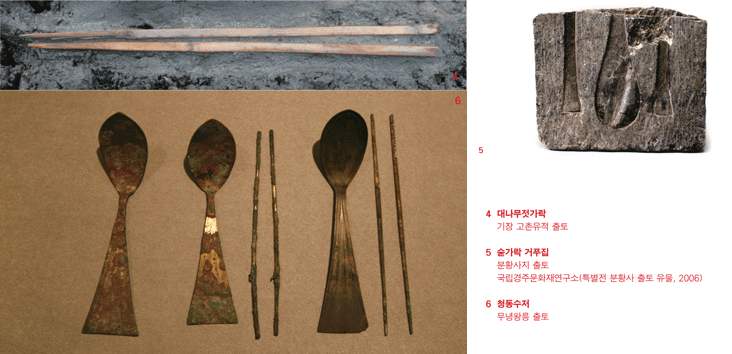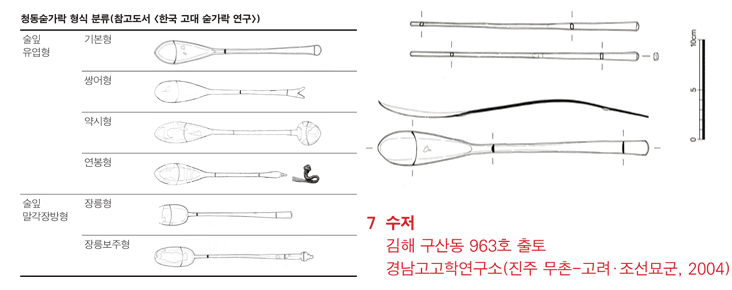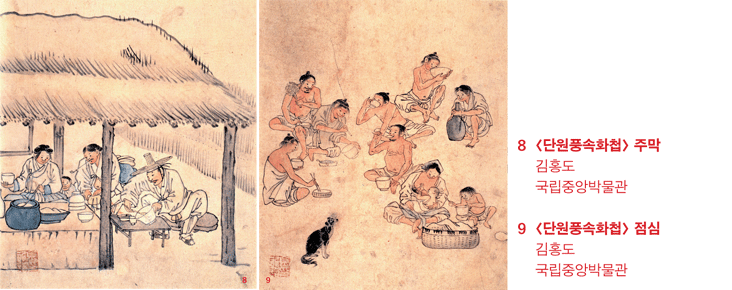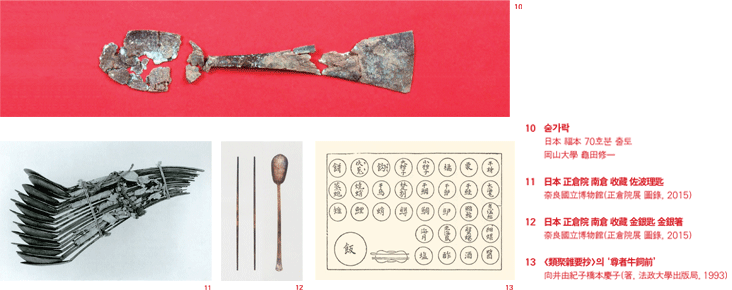참여/소식
국유정담

다르게 정착되었다. 수저 사용은 섭취하는 음식물의 변화와 관련이 있을 것으로 추정되지만
구체적으로 왜, 언제부터 그렇게 되었을까 하는 답을 얻기는 쉽지 않은 일이다.
중국
중국에서는 한국이나 일본과 달리 젓가락을 ‘저箸’보다는 ‘쾌자筷子’로 표현한다. 상아, 옥, 금, 은, 청동, 나무 등으로 제작하고 단면은 방형, 원형, 다각형 등으로 다양하다. <예기>에 의하면 “함께 밥을 먹을 때 땀 난 손으로 먹지 않는다” 또 “기장밥을 젓가락으로 먹지 않는다” 라고 하여 밥을 먹을 때는 손을 사용하였고 젓가락을 사용하지 않았음을 알 수 있다. 또한 “국에 나물이 있는 것은 젓가락을 쓰고 나물이 없는 것은 젓가락을 쓰지 않는다”라고 하였으니 국에 건더기가 있을 때 젓가락을 사용한 것을 알 수 있다.
기록에는 상나라 주왕이 상아로 만든 젓가락을 사용하였다고 하는데 젓가락은 처음에는 나무, 상주시대에는 청동, 한나라 때 대나무로 만들었다. 수·당대에는 청동이나 은젓가락에 금도금을 하기도 하였으며 이후 명·청대까지 사용되었다. 화려한 장식은 한대에 나타나며, 명청시대에는 시나 그림을 새겨 하나의 예술품으로 만들기도 하였다.
산동성과 산서성, 하남성과 하북성을 중심으로 국자나 숟가락이 출토된 유적에서는 신석기시대에 도제로 만든 국자가 출토되다가 은대에 이르러 국자와 숟가락이 출토되기 시작한다. 유물들은 주로 주거지와 분묘에서 출토되고 있으며, 이러한 전통은 전국시대까지 이어진다. 전국시대에 이르면 도제로 만든 국자가 출토되는 예도 있지만 주된 경향은 청동제 국자와 숟가락을 무덤에 부장한 것으로 볼 수 있다.
한대에 이르면 이러한 전통은 일변하여 도제로 제작된 국자와 숟가락이 주류를 이루는 가운데 칠기로 제작한 예도 있고 청동으로 제작한 예도 가끔씩 출현한다. 낙랑에서 칠기로 제작한 국자와 숟가락이 출토된 예를 보아도 한대에는 칠기제작한 숟가락과 국자를 애용했음을 알 수 있다. 이와 관련된 대표적인 유적으로는 장사 마왕퇴 1호 한묘가 있다.
한나라를 지나 위진남북조 시대에 이르기까지 분묘에서 출토되는 청동숟가락과 젓가락은 그 출토 예가 드물다. 도제 숟가락 또는 국자의 부장 빈도가 획기적으로 증가하는 것으로 보아 빠르면 5세기, 늦어도 6세기경에 좀 더 넓은 계층에서 숟가락을 개별적으로 이용한 것으로 보인다.
그리고 수당에 이르러 은제로 제작한 국자나 숟가락이 분묘에서 출토되고 젓가락도 본격적으로 나오기 시작한다. 이러한 장례습속은 중국 북방의 거란과 여진의 요·금, 몽골의 원나라를 거치면서 더욱 성행하여 숟가락의 사용은 중국 전 지역으로 확대된다. 아울러 당대까지 말각장방형의 술에 자루 끝을 능형으로 마감하는 전통적인 형식에 머물렀지만, 요금대에는 숟가락의 자루가 길어지거나 자루 끝에 쌍어를 새기는 쌍어형이 등장한다. 또한 숟가락이 식탁의 필수품으로 자리 잡으면서 장릉형이라는 새로운 형식이 탄생한다.
명은 남경을 중심으로 일어난 한족의 나라로 북방의 여진, 거란, 몽골 등과는 식음문화의 전통을 달리하고 있었다. 명대에 이르면 젓가락만으로 식사를 하였던 것으로 보인다. 이러한 커다란 변화는 명 왕조의 성립, 특히 수도를 베이징으로 옮긴 것이 원인이 되었을 것이다. 궁정과 문무백관과 함께 많은 남방 사람이 북방으로 이주하면서 남송 때 북방 음식과 남방 음식이 결합되어 성립된 음식문화가 다시 북쪽으로 옮겨가 남북이 새롭게 통합되는 중국요리가 탄생하였고, ‘쾌자’라는 새로운 이름의 젓가락만으로 밥을 먹는 풍습이 중국 전역으로 퍼진 것은 이 무렵이었을 것이다.

China
In China chopsticks are made of various materials such as ivory, jade, gold, silver, bronze and wood in round, square or multi-angled form. The ancient Chinese text Book of Rites states that “When eating with others, one does not eat with a sweaty hand” and “Millet rice is not eaten with chopsticks.” From this we can tell that rice was eaten with the hands, and chopsticks were not originally used. They were used, however, when eating soup containing solid ingredients.
Historical records state that King Zhou of the ancient Shang Dynasty used ivory chopsticks, but generally chopsticks were made of wood at first, then bronze in the Shang and Zhou dynasties, and bamboo in the Han Dynasty. Then in the Sui and Tang dynasties silver chopsticks were gilded, a trend that continued in the Ming and Qing dynasties. Some Han Dynasty chopsticks were lavishly decorated while those of the Ming and Qing periods were engraved with poems and pictures, which turned them into works of art.
Spoon-type relics from the prehistoric period are mostly pottery ladles, while spoons and ladles are found together from the Yin Dynasty. In the tombs of the Warring States period, pottery ladles were occasionally found, but the main trend was the burial of bronze spoons and ladles together in tombs. But relics from the Han Dynasty show a complete change, as pottery ladles and spoons form the mainstream, with occasional discoveries of lacquered or bronze examples. In the Wie, Jin and Southern and Northern dynasties period came a radical increase in the number of such pottery eating utensils buried with the dead, indicating the widespread use of spoons around the 5th and 6th centuries. Silver spoons or ladles are found in tombs from the Sui and Tang dynasties, and chopsticks are also found in significant numbers from this time. The custom of burial with such items became more strongly established through the Khitans in northern China and the Liao and Jin dynasties founded by the Khitans and Jurchens, and the Yuan Dynasty founded by the Mongols. Indeed, this custom spread throughout China, indicating that the spoon had become indispensable on the dining table. Then in the Ming Dynasty, the habit of eating with chopsticks only became the norm.

한국
한국에서 가장 오래된 청동수저는 무령왕릉에서 출토된 것이다. 무령왕릉에서는 수저 2벌이 왕과 왕비의 관 앞에서 수습되었고, 또 하나의 청동숟가락이 왕비의 두침 부근에 있던 청동광구발 내부에서 은장도자와 함께 출토되었다. 이외에도 청동 숟가락은 논산 표정리유적이나 청주 신봉동유적 등에서 발견되어 백제 귀족문화의 단면을 잘 보여주고 있다.
아울러 지금까지 저습지유적에서 다양한 목기가 출토되었으나 숟가락으로 단정 지을 만한 것은 없고 오히려 나무 주걱이나 국자 등이 대부분을 차지한다. 부산 고촌유적에서 출토된 대나무로 제작된 한 쌍의 젓가락은 길이 28cm 내외로 제사용으로 보인다. 그리고 왕흥사 목탑지 심초석 남쪽 모서리를 중심으로 다량의 사리 장엄구가 출토되었는데 이때 젓가락도 함께 나왔다.
통일신라시대 숟가락으로는 안압지에서 출토된 것이 대표적인데 술잎의 끝이 뾰족하고 자루를 세장한 것이 특징이다. 이 숟가락과 같은 형태가 일본 정창원에 소장되어 있어 당시 일본과의 교류를 잘 보여주고 있다. 또한 왕경유적의 가옥에서 청동숟가락이 출토되고 분황사지에서는 숟가락 거푸집이 출토되었다. 이는 숟가락의 사용 계층이 확대되고 숟가락의 형태와 제작 과정을 보여주는 자료이다. 이외에도 부소산, 이천 설성산성, 호암산성 우물지에서도 숟가락이 출토되어 전국적인 분포를 보이고 있다. 일본 정창원에 소장된 신라의 청동숟가락이 모두 2점을 1세트로 보관되고 있는데 아마도 음식을 떠오는 것과 입으로 직접 넣는 역할을 따로 하였을 것으로 생각되고, 아울러 안압지에서는 한 점의 젓가락도 출토되지 않은 점과 정창원에 소장된 젓가락은 한 쌍뿐인 것도 이와 같은 사정을 반영하는 것으로 보인다. 고려시대에 들어서면 요·금의 영향으로 수저 사용에 새로운 전기가 마련된다. 11세기경에는 분묘에서 숟가락이 출토되기 시작하고, 12세기 왕의 무덤과 귀족들의 화장묘에는 숟가락을 부장했다. 이러한 경향은 원의 지배를 받는 13세기 후반에 더욱 확산되었고 16세기 말까지 지속된다.

11세기부터 16세기 말까지 약 500년간 숟가락은 통일신라시대와는 다른 형태로 변화한다. 술은 유엽형에 자루는 술목에서 휘어지면서 곡선을 이루고 끝은 호형으로 마감되는 것(기본형), 기본형에서 자루의 끝이 둘로 나누어지는 것(쌍어형), 자루 끝에 소형의 술이 부가되는 것(약시형), 자루 끝에 연봉이 달린 것(연봉형), 술의 형태가 말각장방형에 자루가 술목에서 세장하게 이어지는 것(장릉형) 등으로 분류된다.
고려시대 분묘에서는 젓가락도 출토되지만 대부분의 식탁에서 일반적으로 사용되었다고 보기는 어려울 듯하다. 예를 들면 단양 현곡리에서는 고려분묘 33기가 발굴조사되어 이 분묘의 주인공들은 남한강 상류지역에 토착하였던 지방세력이었을 것으로 짐작되었다. 이 가운데 청동숟가락은 9점(9/33으로 33%), 젓가락은 모두 청동제로 4벌(4/33이니 12%)이 출토되었다. 그러므로 고려시대까지도 젓가락은 일반적으로 사용되었다고 보기 어렵고 일부 집안에서 젓가락을 사용하는 정도였을 것으로 볼 수 있다는 것이다. 그런데 최근 출수된 태안 마도선에서 다수의 나무젓가락이 출토되고 고려가요 <동동>에 분지나무로 깎은 젓가락이 언급되어 고려 사람들은 나무젓가락을 많이 사용하였을 것으로 생각되는 부분이 없지 않다. 그러나 청동젓가락이 청동숟가락과 같이 사용된 것이라면 그렇게 많은 나무젓가락과 함께 나무숟가락도 한 점쯤 출수되어야 하는 것이 정상 아니겠는가. 또한 <고려도경>에 고려에서는 국수가 비싸고 구하기 어려운 음식이라고 하였는데 조운선의 선군들이 그 귀한 국수를 먹기 위해 젓가락을 사용하였다는 것은 이해하기 어려운 상황이 아닐까 한다.
숟가락과 젓가락의 변화는 당시 섭취하는 음식물의 변화와 관련지어 보아야 한다는 의견은 지속적으로 제기되었다. 원의 지배를 겪으면서 고려의 식탁에는 국이 빠질 수 없었다. 이로 인해 숟가락의 사용은 더욱 증가하게 되었고, 이는 조선시대에도 그대로 이어졌다. 지역에 따라 약간의 차이는 있지만 조선시대 전기에는 기본형이나 쌍어형을 사용하였다고 할 수 있다. 젓가락의 출토비는 경남지역을 중심으로 살펴보면 10%대를 유지할 정도지만, 수저가 출토되지 않은 분묘의 경우도 포함한다면 젓가락의 출토비는 10%를 유지하기 어렵고 이것이 조선시대 전기의 젓가락 사용 경향이라고 보아도 무방할 것으로 생각된다.
조선시대 후기에 들면 이상하게도 16세기까지 유행하던 여러 형식의 숟가락이 거의 한꺼번에 사라지고 지금 우리가 사용하는 둥근 술에 일자형 자루가 술목에 부가되는 형식의 숟가락으로 정착된다. 이러한 갑작스런 변화의 원인은 구체적인 자료가 남아 있지 않아 추정하기 쉽지 않다. 그 배경은 <주자가례>에 의거한 상례가 일반화되면서 숟가락도 하나의 형식으로 통일되지 않았을까 추정해보지만 뚜렷한 근거가 있는 것은 아니다. 다만 숟가락의 자루각이 10。도 이하로 떨어지면서 직선화된 것은 16세 말에 나타난 현상이며, 임진왜란을 계기로 전래된 새로운 농작물과 18세기 들어 많은 요리서들이 등장한 것은 숟가락의 변화와 더불어 같이 생각해보아야 할 점이다.
이 시기에 제작된 김홍도와 김득신의 풍속화에 젓가락을 사용하는 장면이 남은 것은 젓가락의 사용도 아울러 증가하였음을 보여주는 좋은 자료라고 하겠다.

Korea
The oldest spoon and chopsticks found in Korea is the bronze set discovered in the Tomb of King Muryeong of the Baekje Kingdom. Up till that time, various wooden utensils had been discovered in low-lying wetland areas, but most resembled soup ladles and none could be positively identified as a spoon.
The major spoon relics from the Unified Silla period are those consisting of a pointed bowl and thin handle found at the Anapji pond site in Gyeongju. Spoons of similar shape are preserved at the Shosoin treasure house in Nara, Japan, reflecting exchange between Korea and Japan at the time. The discovery of bronze spoons at dwelling sites among the archaeological remains of Gyeongju, the ancient capital of Silla, indicates that the use of spoons had spread beyond the upper class. Spoons have also been excavated from mountain fortresses such as Buso-sanseong, Seolseong-sanseong in Icheon, and the well site at Hoam-sanseong, indicating their dispersion around the nation, though no chopsticks were found with them. New developments came in the use of the spoon during the Goryeo Dynasty (918-1392), under the influence of the Liao and Jin dynasties of China. Tomb excavations show that from the 11th century spoons were buried with the dead, and that from the 12th century they were placed in the tombs of royalty and also buried with the cremated remains of the aristocracy. This trend grew stronger in the latter half of the 13th century when Goryeo was under the control of the Yuan Dynasty and continued till the late 16th century. Over those years, the spoon changed in shape from that of the Unified Silla period. Chopsticks were occasionally discovered with the spoons. A large number of wooden chopsticks were recovered from the Madoseon shipwreck off the coast of Taean, and chopsticks made of prickly ash wood are mentioned in the Goryeo song “Dong Dong.” From these circumstances it can be surmised that wooden chopsticks were widely used by the Goryeo people.
Scholars have continually argued that changes in chopsticks must be studied in association with changes in food. After Yuan control in the Goryeo Dynasty, soup became a firmly established part of the typical Korean meal and the use of spoons would have increased even further. Such ways continued in the subsequent Joseon Dynasty, when no noticeable change in the use of the spoon occurred. But the varied types of spoons used from the latter half of Joseon almost disappeared at once in the 16th century, leaving only the kind of spoon that we still use today in the form of round bowl attached to a straight handle. Little material remains to shed light on this sudden change, which makes it hard to draw any conclusions. The genre paintings of this time by Kim Hong-do and Kim Deuk-sin which show the use of chopsticks can be taken as evidence that the use of chopsticks had increased with the use of spoons.
일본
선사시대에 출토된 유물은 대부분 음식을 뜨는 국자를 나무나 흙으로 구워 제작한 것이며, 본격적인 숟가락은 福本 70호분에서 출토된 청동숟가락일 것이다. 7세기 전반경으로 편년되는 이 고분에서는 백제 무령왕릉에서 출토된 것과 거의 동일한 형태의 숟가락이 출토되었다.
8세기를 지나면서 정창원에는 음식과 관련된 보물이 다수 전해 내려온다. 용기류와 함께 많이 전래되는 것 중 하나가 숟가락으로 이 숟가락 외에도 佐波理 숟가락 1개, 동숟가락 345개(훗날 조사에서 佐波理制로 판명)가 대표적이다. 또한 당에서 제작된 것으로 알려진 금도금은제 숟가락과 젓가락이 한 벌 전하고 있다
九州의 大宰府에서는 길이가 32cm에 달하고 끝에는 고리가 달린 청동젓가락이, 福岡市의 三宅廢寺에서는 신라계의 청동숟가락 2점이 출토되었다. 佐賀縣 下中杖遺跡에서는 젓가락만 출토되었는데 시기는 9세기 전반경이며 길이는 26cm 정도이다. 또한 飛鳥板蓋宮이나 藤原京内에서는 노송나무제 젓가락 한 쌍이 출토되었고, 平城京에서는 더욱 많은 노송나무제 젓가락이 출토된 것으로 보아 귀족을 중심으로 목제 젓가락을 사용한 식사법이 보급된 듯하다. 그리고 동북지방의 秋田城에서 생활용구와 함께 17.2~17.7cm 길이의 젓가락이 다수 출토되기도 하였다.
한편 天平 19년(747) 大安寺의 재산 목록인 <大安寺伽藍縁起并流記資財帳>에는 숟가락 31개가 젓가락 12세트와 함께 기록되어 있고, 養老 6년(722) 元正天皇으로부터 하사받은 공양구 세트 기록에는 백동제 수저가 포함되어 있다. 天平 19년(747) <法隆寺伽藍縁起并流記資財帳>에도 대안사와 거의 같은 시기에 元正天皇이 하사한 공양구 세트 중에 백동제 숟가락과 折箸가, 天平 5년(761)의 <法隆寺東院縁起資財帳>에는 은제 수저 세트가 한 벌 있다고 기록되어 있다. 대안사의 젓가락은 모두 공양구라고 명기되어 있는 것으로 보아 나라 시대의 각 사원에서 백동이나 은과 같은 금속제 수저가 공양구로 사용된 것을 알 수 있다. 식탁에서 숟가락이 탈락하고 일본적인 젓가락 문화가 확립되어간 시기는 9세기를 지나면서일 것이다. 9세기 초의 유적인 秋田縣 五城目町 中谷地遺跡에서는 숟가락은 보이지 않고 젓가락만 채식용 그릇과 함께 출토되었다. 그리고 鎌倉時代에 성립된 것으로 보이는 <廚事類記>의 ‘調備部’를 보면 식사에는 은제와 목제 젓가락과 숟가락이 각각 한 벌로 제공되었는데 은제 젓가락은 식전에 밥을 바칠 때 사용되고 나무젓가락으로는 밥과 진미를, 은제 숟가락으로는 국을 뜨고, 나무젓가락으로는 반찬 이것저것을 집는 데 사용하여 재질로서 용도를 구분하는 귀족적인 수저의 사용이 나타나 있다. 또한 1136년에 제작된 <類聚雜要抄> ‘尊者牛飼前’의 상차림에는 箸匙를 표기하고 있으나 젓가락을 먼저 쓰고 숟가락을 뒤로 하였다.
그러나 12세기 후반에 제작된 <信貴山緣起繪卷>에는 나그네의 방문에 어린아이가 한 손에 칠완을 들고 한손에는 젓가락만 들고 서 있는 장면이 그려져 있고, 같은 시기에 제작된 <一遍上人繪傳>에는 걸식을 하는 자에게 젓가락이 필수라고 하였다. 當麻寺 曼茶羅堂 앞에는 걸인이 젓가락으로 밥을 먹는 장면이 그려져 있는 것으로 보아 일본에서 젓가락으로 밥을 먹는 습속이 12세기 후반에는 확립된 것으로 볼 수 있다.

Japan
The spoons excavated in Japan show no great differ-ences to Korean spoons. Those from prehistoric times are mostly wooden or pottery utensils used to ladle soup or other foods. The earliest bronze spoons date to the first half of the 7th century made of bronze. They are of almost exactly the same shape as the spoon found in the tomb of King Muryeong of Baekje in Korea. Shosoin in Japan has many food related relics from after the 8th century, and one of the most common items handed down with food vessels is the spoon. Along with hundreds of bronze spoons in the collection is a pair of chopsticks and spoon made of silver plated with gold, known to be a product of the Tang Dynasty of China.
It was after the 9th century that the spoon started to disappear from the table and the Japanese began to establish dining customs based on chopsticks. In archaeological remains of the 9th century, spoons are not found while chopsticks are found with dishes largely designed for vegetable-based foods. Also, according to records from the Kamakura period a pair of silver chopsticks and spoon was provided along with a wooden set with meals. The silver chopsticks were used for serving out rice, while the wooden chopsticks were used to eat the rice and side dishes and the silver spoon to put soup into a bowl. That is, utensils of different materials were used according to the food eaten, pointing to aristocratic dining practices.
A catalogue dating to the latter half of the 12th century contains a painting featuring a child carrying a bowl in one hand and a pair of chopsticks in the other. Another record states that a pair of chopsticks is a necessary items for a person who begs for his food. These materials suggest that the custom of eating meals with chopsticks alone was established in Japan around this time.
글을 마치며
T한국은 숟가락을 밥 먹는 내내 사용하지만 중국은 숟가락을 국湯을 먹을 때만 사용하고 일본에서는 거의 젓가락만 사용하여 식사한다. 한식에서 숟가락이 식탁을 대표하는 도구가 된 것은 국이 빠지지 않기 때문이고, 그러한 전통은 고려 말 이후 확립된 것으로 볼 수 있다. 오늘날 중국에서 쾌자를 이용하여 식사하는 전통은 명대 이후 확립된 것이며, 일본에서 숟가락이 식탁에서 사라진 것은 12세기를 지나면서부터로 보인다.
결국 숟가락은 중국 상대 이후 제사에서 사용되던 도구가 개인용으로 사용되게 되었고, 그것이 한국과 일본에 전파되었으나 각국의 문화적 환경에 따라 식탁에서 수저의 사용은 다른 결과를 보이고 있다. 하나의 식도구가 각각 다른 문화 반응을 보인 것으로, 이것은 동양 삼국의 문화적 정체성을 보여주는 또 다른 현상이라고 보아도 좋을 것이다.
Conclusion
While the spoon is used throughout the whole meal in Korea, in China it is used only when eating soup and in Japan chopsticks are mainly used throughout the meal. The spoon came to be the main eating utensil of Korean cuisine because soup is always part of the meal, a tradition established in the late Goryeo Dynasty. The current Chinese custom of eating with chopsticks only appeared in the Ming Dynasty, and in Japan the spoon all but disappeared from the table after the 12th century.
Therefore, the spoon, a utensil used in rites from the ancient Shang Dynasty in China, developed into a personal dining utensil and then spread to Korea and Japan, where it came to be used in different ways according to the cultural environment of each country. The different cultural responses to the same item can be seen as the manifestation of the cultural identity of each of the three countries.


















